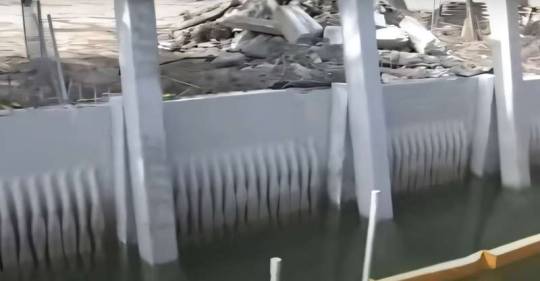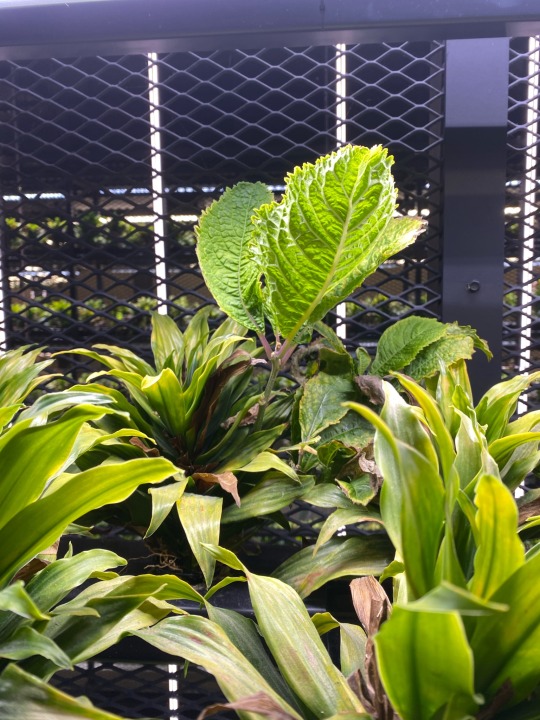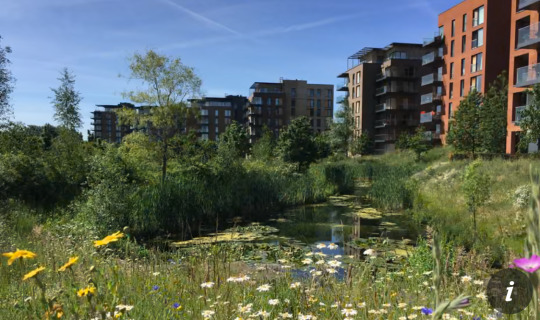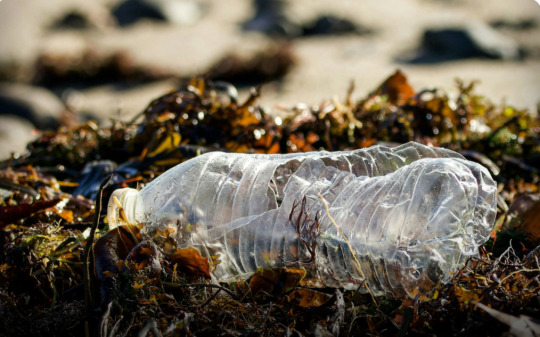#Green Infrastructure
Explore tagged Tumblr posts
Text
As relentless rains pounded LA, the city’s “sponge” infrastructure helped gather 8.6 billion gallons of water—enough to sustain over 100,000 households for a year.
Earlier this month, the future fell on Los Angeles. A long band of moisture in the sky, known as an atmospheric river, dumped 9 inches of rain on the city over three days—over half of what the city typically gets in a year. It’s the kind of extreme rainfall that’ll get ever more extreme as the planet warms.
The city’s water managers, though, were ready and waiting. Like other urban areas around the world, in recent years LA has been transforming into a “sponge city,” replacing impermeable surfaces, like concrete, with permeable ones, like dirt and plants. It has also built out “spreading grounds,” where water accumulates and soaks into the earth.
With traditional dams and all that newfangled spongy infrastructure, between February 4 and 7 the metropolis captured 8.6 billion gallons of stormwater, enough to provide water to 106,000 households for a year. For the rainy season in total, LA has accumulated 14.7 billion gallons.
Long reliant on snowmelt and river water piped in from afar, LA is on a quest to produce as much water as it can locally. “There's going to be a lot more rain and a lot less snow, which is going to alter the way we capture snowmelt and the aqueduct water,” says Art Castro, manager of watershed management at the Los Angeles Department of Water and Power. “Dams and spreading grounds are the workhorses of local stormwater capture for either flood protection or water supply.”
Centuries of urban-planning dogma dictates using gutters, sewers, and other infrastructure to funnel rainwater out of a metropolis as quickly as possible to prevent flooding. Given the increasingly catastrophic urban flooding seen around the world, though, that clearly isn’t working anymore, so now planners are finding clever ways to capture stormwater, treating it as an asset instead of a liability. “The problem of urban hydrology is caused by a thousand small cuts,” says Michael Kiparsky, director of the Wheeler Water Institute at UC Berkeley. “No one driveway or roof in and of itself causes massive alteration of the hydrologic cycle. But combine millions of them in one area and it does. Maybe we can solve that problem with a thousand Band-Aids.”
Or in this case, sponges. The trick to making a city more absorbent is to add more gardens and other green spaces that allow water to percolate into underlying aquifers—porous subterranean materials that can hold water—which a city can then draw from in times of need. Engineers are also greening up medians and roadside areas to soak up the water that’d normally rush off streets, into sewers, and eventually out to sea...
To exploit all that free water falling from the sky, the LADWP has carved out big patches of brown in the concrete jungle. Stormwater is piped into these spreading grounds and accumulates in dirt basins. That allows it to slowly soak into the underlying aquifer, which acts as a sort of natural underground tank that can hold 28 billion gallons of water.
During a storm, the city is also gathering water in dams, some of which it diverts into the spreading grounds. “After the storm comes by, and it's a bright sunny day, you’ll still see water being released into a channel and diverted into the spreading grounds,” says Castro. That way, water moves from a reservoir where it’s exposed to sunlight and evaporation, into an aquifer where it’s banked safely underground.
On a smaller scale, LADWP has been experimenting with turning parks into mini spreading grounds, diverting stormwater there to soak into subterranean cisterns or chambers. It’s also deploying green spaces along roadways, which have the additional benefit of mitigating flooding in a neighborhood: The less concrete and the more dirt and plants, the more the built environment can soak up stormwater like the actual environment naturally does.
As an added benefit, deploying more of these green spaces, along with urban gardens, improves the mental health of residents. Plants here also “sweat,” cooling the area and beating back the urban heat island effect—the tendency for concrete to absorb solar energy and slowly release it at night. By reducing summer temperatures, you improve the physical health of residents. “The more trees, the more shade, the less heat island effect,” says Castro. “Sometimes when it’s 90 degrees in the middle of summer, it could get up to 110 underneath a bus stop.”
LA’s far from alone in going spongy. Pittsburgh is also deploying more rain gardens, and where they absolutely must have a hard surface—sidewalks, parking lots, etc.—they’re using special concrete bricks that allow water to seep through. And a growing number of municipalities are scrutinizing properties and charging owners fees if they have excessive impermeable surfaces like pavement, thus incentivizing the switch to permeable surfaces like plots of native plants or urban gardens for producing more food locally.
So the old way of stormwater management isn’t just increasingly dangerous and ineffective as the planet warms and storms get more intense—it stands in the way of a more beautiful, less sweltering, more sustainable urban landscape. LA, of all places, is showing the world there’s a better way.
-via Wired, February 19, 2024
#california#los angeles#water#rainfall#extreme weather#rain#atmospheric science#meteorology#infrastructure#green infrastructure#climate change#climate action#climate resilient#climate emergency#urban#urban landscape#flooding#flood warning#natural disasters#environmental news#climate news#good news#hope#solarpunk#hopepunk#ecopunk#sustainability#urban planning#city planning#urbanism
14K notes
·
View notes
Text
Dandelion News - January 15-21
Like these weekly compilations? Tip me at $kaybarr1735 or check out my Dandelion Doodles!
1. Landmark debt swap to protect Indonesia’s coral reefs

“The government of Indonesia announced this week a deal to redirect more than US$ 35 million it owes to the United States into the conservation of coral reefs in the most biodiverse ocean area on Earth.”
2. [FWS] Provides Over $1.3 Billion to Support Fish and Wildlife Conservation and Outdoor Access

“Through these combined funds, agencies have supported monitoring and management of over 500 species of wild mammals and birds, annual stocking of over 1 billion fish, operations of fish and wildlife disease laboratories around the country, and provided hunter and aquatic education to millions of students.”
3. Philippine Indigenous communities restore a mountain forest to prevent urban flooding

“Indigenous knowledge systems and practices are considered in the project design, and its leaders and members have been involved throughout the process, from agreeing to participate to identifying suitable land and selecting plant species that naturally grow in the area.”
4. Responsible Offshore Wind Development is a Clear Win for Birds, the U.S. Economy, and our Climate

“[T]he total feasible offshore wind capacity along U.S. coasts is more than three times the total electricity generated nationwide in 2023. […] Proven strategies, such as reducing visible lights on turbines and using perching deterrents on turbines, have been effective in addressing bird impacts.”
5. Illinois awards $100M for electric truck charging corridor, Tesla to get $40M

“The project will facilitate the construction of 345 electric truck charging ports and pull-through truck charging stalls across 14 sites throughout Illinois[…. E]lectrifying [the 30,000 daily long-haul] trucks would make a huge impact in the public health and quality of life along the heavily populated roadways.”
6. Reinventing the South Florida seawall to help marine life, buffer rising seas

“[The new seawall] features raised areas inspired by mangrove roots that are intended to both provide nooks and crannies for fish and crabs and other marine creatures and also better absorb some of the impact from waves and storm surges.”
7. Long Beach Commits to 100% All-Electric Garbage Trucks
“[Diesel garbage trucks] produce around a quarter of all diesel pollution in California and contribute to 1,400 premature deaths every year. Electric options, on the other hand, are quieter than their diesel counterparts and produce zero tailpipe emissions.”
8. ‘This Is a Victory': Biden Affirms ERA Has Been 'Ratified' and Law of the Land

“President Joe Biden on Friday announced his administration's official opinion that the amendment is ratified and its protections against sex-based discrimination are enshrined in the U.S. Constitution.”
9. A Little-Known Clean Energy Solution Could Soon Reach ‘Liftoff’

“Ground source heat pumps could heat and cool the equivalent of 7 million homes by 2035—up from just over 1 million today[…. G]eothermal energy is generally considered to be more popular among Republicans than other forms of clean energy, such as wind and solar.”
10. Researchers combine citizens' help and cutting-edge tech to track biodiversity

“Researchers in the project, which runs from 2022 to 2026, are experimenting with tools like drones, cameras and sensors to collect detailed data on different species, [… and] Observation.org, a global biodiversity platform where people submit pictures of animals and plants, helping to identify and monitor them.”
January 8-14 news here | (all credit for images and written material can be found at the source linked; I don’t claim credit for anything but curating.)
#good news#hopepunk#nature#national debt#coral reef#conservation#funding#fish and wildlife#philippines#indigenous#agroforestry#green infrastructure#offshore wind#wind energy#electric vehicles#illinois#florida#sea wall#habitat#california#equal rights#human rights#us politics#geothermal#biodiversity#citizen science#climate change#invasive species#endangered species#clean energy
281 notes
·
View notes
Text





115 notes
·
View notes
Text
What is Green Infrastructure?
Runoff from stormwater continues to be a major cause of water pollution in urban areas. It carries trash, bacteria, heavy metals, and other pollutants through storm sewers into local waterways. Heavy rainstorms can cause flooding that damages property and infrastructure.
Historically, communities have used gray infrastructure—systems of gutters, pipes, and tunnels—to move stormwater away from where we live to treatment plants or straight to local water bodies. The gray infrastructure in many areas is aging, and its existing capacity to manage large volumes of stormwater is decreasing in areas across the country. To meet this challenge, many communities are installing green infrastructure systems to bolster their capacity to manage stormwater. By doing so, communities are becoming more resilient and achieving environmental, social and economic benefits.

Basically, green infrastructure filters and absorbs stormwater where it falls. In 2019, Congress enacted the Water Infrastructure Improvement Act, which defines green infrastructure as "the range of measures that use plant or soil systems, permeable pavement or other permeable surfaces or substrates, stormwater harvest and reuse, or landscaping to store, infiltrate, or evapotranspirate stormwater and reduce flows to sewer systems or to surface waters."

Green infrastructure elements can be woven into a community at several scales. Examples at the urban scale could include a rain barrel up against a house, a row of trees along a major city street, or greening an alleyway. Neighborhood scale green infrastructure could include acres of open park space outside a city center, planting rain gardens or constructing a wetland near a residential housing complex. At the landscape or watershed scale, examples could include protecting large open natural spaces, riparian areas, wetlands or greening steep hillsides. When green infrastructure systems are installed throughout a community, city or across a regional watershed, they can provide cleaner air and water as well as significant value for the community with flood protection, diverse habitat, and beautiful green spaces.
63 notes
·
View notes
Text
youtube
✅ Making cities resilient to floods
About 44% of all disaster events around the world are flood-related.
In our new explainer episode, we show how ‘sponging’ cities can help them overcome the challenge of flooding while strengthening the local ecology, and boosting the economic and social well-being of residents.
In this episode, you will learn:
🟡 What a sponge city is (and how it works)
🟡 The benefits of ‘sponging’ cities (beyond flood-resilience)
🟡 Projects that demonstrate the principles and benefits of a sponge city at various scales (and what we can learn from them)
🟡 Why developers should be in favour of sponge city initiatives (they can save millions in costs)
And much more!
💚 If you gain value from this conversation, we hope you will subscribe to the channel 💚
Thank you to Holcim Foundation for Sustainable Construction for supporting season 5 of Ecogradia.
----------------------------------------------------------------------
Timestamps
00:00 Intro
01:43 What is a sponge city?
02:08 Features of a sponge city
04:16 Is 'sponging' expensive?
04:44 Benefits of a sponge city
08:19 The man who pioneered sponge cities
09:01 Yanweizhou Park | Jinhua, China
09:46 Why Bangkok and Jakarta are sinking
10:39 Tebet Eco Park | Jakarta, Indonesia
11:36 Chulalongkorn University Centenary Park | Bangkok, Thailand
12:13 Copenhagen's Cloudburst Management Plan
13:14 Sankt Kjelds Plads | Copenhagen, Denmark
14:06 How sponge cities can profit: Bishan-Ang Mo Kio Park | Singapore
15:46 How sponge cities can profit: Portland | USA
16:21 Outro
----------------------------------------------------------------------
This episode features the following projects:
Yanweizhou Park | Jinhua, China (2014)
Designed by Turenscape
Tebet Eco Park | Jakarta, Indonesia (2022)
Designed by SIURA Studio
Chulalongkorn University Centenary Park | Bangkok, Thailand (2017)
Designed by LANDPROCESS
Sankt Kjeld's Square & Bryggervangen | Copenhagen, Denmark (2019)
Designed by SLA
Bishan-Ang Mo Kio Park | Singapore (2012)
Designed by Henning Larsen
Also featuring:
Fish Tail Park | Nanchang, China (2022)
Designed by Turenscape
Benjakitti Park | Bangkok, Thailand (2022)
Designed by Turenscape + Arsomsilp Community and Environmental Architect
Hunter’s Point South Waterfront Park | New York City, USA (2018)
Designed by SWA/Balsley + Weiss/Manfredi in collaboration with Arup
Houtan Park | Shanghai, China (2010)
Designed by Turenscape
High Plains Environmental Center | Loveland, USA
Designed by Hauser Architects
Thammasat Urban Rooftop Farm | Bangkok, Thailand (2019)
Designed by LANDPROCESS
Khoo Teck Puat Hospital | Singapore (2010)
Designed by CPG Consultants in collaboration with RMJM Architecture
Shangrao Xinjiang Ecological Park | Shangrao, China
Designed by Turenscape
Telok Blangah Hill Park | Singapore
Interlace Apartments | Singapore (2013)
Designed by OMA in collaboration with RSP
Jiangsu—Victoria Sponge City Innovation Park | Kunshan, China
Designed by CRC for Water Sensitive Cities
Quzhou Luming Park | Quzhou, China (2015)
Designed by Turenscape
OCT OH BAY Retail Park | Shenzhen, China (2021)
Designed by Laguarda.Low Architects
Tanghe 'Red Ribbon' Park | Qinhuangdao, China (2007)
Designed by Turenscape
Sanya Mangrove Park | Sanya, China (2019)
Designed by Turenscape
----------------------------------------------------------------------
We are also available on
Spotify: https://open.spotify.c...
Apple podcasts: https://podcasts.apple...
Website
https://www.ecogradia....
Read about sustainable projects on
https://www.ecogradia....
Subscribe to our fortnightly newsletter
https://ecogradia.us5....
No spamming here! :)
----------------------------------------------------------------------
Follow us on 🖱️
Instagram:  / ecogradia
LinkedIn:  / ecogradia
Twitter: https://x.com/Ecogradia
#Ecogradia #Sustainability #Architecture #SpongeCity #FloodproofCity #ResilientCity #FloodProofCity #GreenSpace
[sustainability, architecture, sponge city, green spaces, floodproof city, resilient city]
#Ecogradia#solarpunk#sponge city#floods#flood#climate crisis#climate change#climate collapse#global heating#global warming#green infrastructure#blue infrastructure#China#Indonesia#thailand#denmark#Singapore#USA#Youtube
18 notes
·
View notes
Text
e360: You’ve been quoted as saying: “There’s no more natural nature. Now it’s a matter of design.” What did you mean by that? Orff: We humans are profoundly impacting the planet. There is no “pure nature” that’s outside of us, untouched up there in the foothills somewhere. We’ve “made” the world what it is already, so now we need to take a very, very strong hand in the remaking. It is a matter of design in the sense that it requires work, intention, design, funding, political skills. It’s not a naive or nostalgic attempt to restore the past. Instead, it’s layering up natural systems to reduce risk, building this hybrid future of stewarded nature. e360: In Staten Island you are building a breakwater offshore, but in other places you have advocated tearing down some built structures to allow water a place to go during floods. Orff: We have to soften our shorelines, we need to remove roadways from critical migration paths. Otherwise, flash flooding will get worse, and our biodiversity will continue to plummet. So a big part of climate adaptation may simply be unbuilding what we’ve already built. Rather than thinking of design as something merely additive or “beautifying,” we need to think about undoing our environmental mistakes, like damming rivers, bulkheading our shorelines, and concretizing streams. We need to start making room for rivers and floods. e360: We’ve tried to control nature with big infrastructure projects. But that can backfire, can’t it? Orff: For decades, infrastructure has been constructed as “single-purpose,” often designed by engineers to isolate one element of a system and to solve one problem. For example, on Staten Island, during Superstorm Sandy, a levee designed to keep water out was overtopped, resulting in a “bathtub effect” that trapped water inside a neighborhood rather than keeping it out and resulted in several deaths. We try to lock natural systems in place. But, of course, that is not the way that natural systems respond, and it is wholly insufficient for a climate-changed environment where we’re experiencing more intense rain in many regions, where we are facing more extreme heat, where sea levels are rising. The old rules, frankly, no longer apply.
141 notes
·
View notes
Text

Nah, one more lane will fix it.
#infrastructure#green energy#green#green infrastructure#climate activism#climate solutions#climate science#climate action#climate justice#climate crisis#climate change#climate catastrophe#trains#traffic#leftist memes#left is best#leftist#leftism#left wing#green party#environment#enviromentalism#environmetalists#meme#funny memes#funny pics#funny post#funny image#funny shit#ha ha funny
11 notes
·
View notes
Text
Minor detail from Illustrhater with absolutely no relevance to the plot, but I adore:
The rooftops now have solar panels and small garden panels.
The s5 finale talked about Ms. Bustier's environmental commitment to as mayor of Paris, but I expected to feature as the occasional environmental advocacy episode like in the past (I'm going to make another post about those). But working this into the background, especially of a setting that is both important and rather unique to the show (rooftops)? I love it. Deliberately showing what a green city could look like and normalizing it? Amazing.
The best part? Rooftop plantings are a real tool used by city planners with the following benefits:
Reduce stormwater pollution
Increase pollinator habitat + connectivity
Decrease urban temperature
Increase mental health
Increase albedo (sunlight reflectivity, which can play into the greenhouse effect)
As an environmental planning major, I could talk about the importance of each of the points quite a bit. This sort of thing is my passion, and I'm delighted to see that my hyperfixation show includes it.
#when hyperfocus meets special interest#mlb s6#miraculous lb#green infrastructure#environmental planning#urban planning#ml illustrhater
8 notes
·
View notes
Text








Working with indoor hydroponic systems has had its challenges, particularly with pesky weeds that love to invade and clog the hydroponic setup with their roots. Additionally, maintaining a proper chemical balance has been tricky, often resulting in nutrient deficiencies that hinder plant growth.
3 notes
·
View notes
Text
In the rich tapestry of botanical wonders, the Jujube Tree, scientifically known as Ziziphus jujuba or Jujube, emerges as a sweet symphony of natural splendor and cultural significance. This charming tree, adorned with small, sweet fruits and lush foliage, not only delights with its flavors but also holds deep-rooted cultural reverence. Join us on a journey through the enchanting world of the Jujube Tree, exploring its sweet treasures, cultural connections, and enduring legacy in traditional practices
#Adapting#agroforestry#Benefits#Biodiversity#Carbon Footprints#carbon sequestration#Children#Climate Change#conservation#Decarbonization#Environmental conservation#Forests#Future#green guardian#Green House Emissions#Green infrastructure#Indian#jujube#Oxygen#Plantation#Pollution#Reforestation#saveearth#Sustainable agriculture#Trees
2 notes
·
View notes
Text

2 notes
·
View notes
Text
Looking around at the problem-solvers in wetsuits and hardhats and sensible boots, earnestly trying to build a safer future with sustainable energy, it’s hard not to catch her mood. The sun slants through the high windows, and the chungus has come to rest on the artificial shoreline, squirting water out of dozens of tiny holes. The soft infrastructure has survived, and with it the hope for a blue economy. For a moment, it does feel like Utopia—or at least a healthier world—might be possible.
#Annalee Newitz#blue infrastructure#green infrastructure#doom scroll break#tech news#sea level rise#article#science#science news#climate change#climate crisis#solar panels#solarpunk
12 notes
·
View notes
Text
Dandelion News - April 8-14
Based on preliminary results of this poll, for the next few weeks I’m gonna test out doing 5 articles a week instead of 10, as part of an effort to maintain my own mental health. If these half-sized posts get markedly fewer notes, I’ll try to figure out a different compromise.
Like these weekly compilations? Tip me at $kaybarr1735 or check out my Dandelion Doodles!
1. Zookeepers prepare Easter treats for animals

“”Our Asiatic lion cubs, who have just turned one, are at a crucial stage in their development, honing their natural exploratory and hunting instincts. Enrichment — like the enormous, scented Easter egg — plays an important role in this, helping to diversify their habitat and encouraging them to fully engage their strength and remarkably keen sense of smell.””
2. ‘People love being here’: London development shows harmony between nature and housing

“[… T]he charmingly named Tadpole Garden Village in Wiltshire will have 28 hectares (68 acres) of green space and nearly 2,000 homes. […] “We were initially brought in to find a nature-based solution to the flooding of the River Quaggy. We linked it to a floodplain and created sustainable urban drainage systems[….]””
3. Federal judge restores AP’s full access to White House events in victory for press freedom

“The ruling affirms that the First Amendment prohibits punishing journalists for refusing to adopt government-mandated language[….] “"Today’s ruling affirms the fundamental right of the press and public to speak freely without government retaliation.””
4. Huge Reductions in Plastic Pollution Along Aussie Coastlines

“[… P]lastic pollution along Australian coastlines has decreased by more than a third (39 per cent) over the past ten years[…. Other research found] a 16 percent increase in areas where no plastic debris was found at all.”
5. Pangolarium: world's first pangolin rehab facility opens in South Africa

“A purpose-built facility like the Pangolarium will give rescued pangolins the best chance at regaining health. Monitored release back into the wild is the goal whenever possible[….] “It will also be a research and conservation hub for pangolin academics, rehabilitators and veterinarians to share information and knowledge[….]””
April 1-7 news here | (all credit for images and written material can be found at the source linked; I don’t claim credit for anything but curating.)
#hopepunk#good news#nature#animals#lion#lion cub#london zoo#zoo#london#uk#housing#green space#green infrastructure#us politics#associated press#freedom of the press#trump administration#first amendment#australia#plastic#pollution#littering#south africa#pangolin#wildlife rehabilitation#wildlife rescue#conservation
156 notes
·
View notes
Text

14 notes
·
View notes
Photo

Landscape - Modern Landscape Photo of a mid-sized modern full sun rooftop mulch landscaping.
2 notes
·
View notes
Text
youtube
How can we work with water, rather than against it, to prevent flooding? Professor Kongjian Yu of Peking University, a pioneer of the “sponge city” concept, dives into holistic, nature-based solutions that can be used in water management. He describes how water is like a beast when it’s backed into a corner: it always wins. But if we can adapt and mitigate, we can work with water to solve the problem both locally and globally. Drawing on the story of how he almost drowned as a child during monsoon season, he advocates for naturalized waterways, which can capture carbon as well as act as a sponge to absorb excess water. He envisions a world where everyone can participate in the sponge cities concept!
Thanks to the James and Cathleen D. Stone Foundation for organizing Professor Yu's visit and for supporting this collaboration with the Stone Living Lab.
Earthshot:  • Earthshot
Among the world's largest science centers, the Museum of Science engages millions of people each year to the wonders of science and technology through interactive exhibitions, digital programs, giant screen productions, and preK – 12 EiE® STEM curricula through the William and Charlotte Bloomberg Science Education Center. Established in 1830, the Museum is home to such iconic experiences as the Theater of Electricity, the Charles Hayden Planetarium, and the Mugar Omni Theater. Around the world, the Museum is known for digital experiences such as Mission: Mars on Roblox, and traveling exhibitions such as the Science Behind Pixar. Learn more at https://www.mos.org/
Copyright © 2024. Museum of Science. All rights reserved. This video is owned by the Museum of Science and may not be reproduced, redistributed, or used in any manner without prior written permission from the Museum of Science.
#Museum of Science#solarpunk#Kongjian Yu#professor Kongjian Yu#sponge city#green infrastructure#blue infrastructure#China#Thailand#USA#climate change#climate collapse#climate crisis#global warming#global heating#flood#flooding#Peking University#Youtube
9 notes
·
View notes